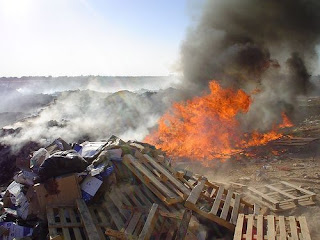Guillermo Contreras
June 5, 2009 - San Antonio Express-News
.....
Six people from Texas, including some soldiers, who claim they were poisoned by toxins and emissions from burn pits at U.S. camps in Iraq and Afghanistan are suing contractors KBR and Halliburton.
The suit, moved to federal court in San Antonio from state court last week, alleges the companies operated the large war-zone pits and burned waste since 2004 that included trucks, tires, plastic water bottles, medical waste, hazardous materials, animal carcasses and even human corpses.
The suit claims burning the waste in open pits - with no safety controls - may have released toxins that harmed at least 100,000 people, including U.S. troops, contractors and civilians.
Lawyers for the plaintiffs are seeking to make the case a class-action lawsuit, citing evidence that many others are having symptoms or medical conditions that include severe respiratory ailments, asthma, sleep apnea, heart problems, tumors, lymphoma and leukemia.
Some even have died, according to the suit and news reports.
The situation has been likened by some observers to that caused by Agent Orange of the Vietnam era.
The suit was filed on behalf of Robert Cain of San Marcos; Craig Henry of San Antonio; Francis Jaeger of Haltom City; David McMenomy of Lampasas; Mark Posz of San Antonio; and El Kevin Sar of Houston.
The six exhibited symptoms ranging from acute abdominal pains, chronic respiratory infections, burning sensations in the lungs and persistent cold-like symptoms.
McMenomy had a football-size tumor removed from his hip suspected of being caused by fumes from a burn pit at Camp Al Taji, Iraq, the suit said.
The six couldn't be reached for comment Wednesday.
Lawyers with Burke O'Neill LLC in Washington have filed lawsuits in 10 states, including the one in San Antonio.
Thirty-four suits have been filed or are expected to be filed in 34 states where people with symptoms have surfaced, plaintiffs' attorney Elizabeth Burke said.
The burn pits are so large, the suit said, that tractors are used to push "every type of waste imaginable" into the fire, and the flames shoot hundreds of feet into the sky, sometimes around the clock.
The suit claims the contractors failed to install incinerators to limit the toxic exposure.
"They took an enormous amount of taxpayer dollars and did shoddy work," Burke said of the contractors. "The work they did harmed the soldiers and hindered the military mission. In some bases with an Air Force presence, planes could not take off and land because of the smoke."
Houston-based KBR said it operated within the rules and regulations set by the U.S. military.
"The general assertion that KBR knowingly harmed troops is unfounded as the safety and security of all KBR employees and those the company serves remains our top priority," said an e-mailed statement from KBR spokeswoman Heather Browne.
Halliburton, which at one time was the parent company of KBR and also is in Houston, questioned why it was named as a defendant.
"As these lawsuits are based on KBR activity in Iraq and Afghanistan, we believe that Halliburton is improperly named in these cases and, as such, we expect Halliburton to be dismissed from the suits as Halliburton would have no responsibility, legal or otherwise, for the actions alleged," Halliburton spokeswoman Diana Gabriel said by e-mail.
Senior members of military environmental health assessment teams have expressed concern about the pits to the Pentagon. One of them called the burn pit at Balad Air Base in Iraq "the worst environmental site I have personally visited" in 10 years.
In May, congressional lawmakers introduced a bill that would prohibit the military from operating burn pits in Iraq and Afghanistan for longer than six months and require the Pentagon to identify service members who already may have been exposed to toxins so they could be treated.
"Disturbing reports are coming to light every day about these burn pits and the toll they are taking on the health of many of our service men and women," said U.S. Rep. Tim Bishop, D-N.Y., who co-authored the bill with U.S. Rep. Carol Shea-Porter, D-N.H. "Our troops should be free to focus on fighting the enemy without worrying how their lives may be further endangered by the actions of private contractors operating under different rules."
Bishop and others set up a Web site - burnpits.org - with information and personal stories about burn pits.
An Air Force memo that was leaked recently on Wikileaks, a Web site that receives documents from anonymous sources to help expose government misdeeds, said thousands of people might have been exposed to toxins at a burn pit at Balad Air Base.
"In my professional opinion, the known carcinogens and respiratory sensitizers released into the atmosphere by the burn pit present both an acute and chronic health hazard to our troops and local population," Lt. Col. James R. Elliott, the chief of aero-medical services, wrote in a December 2006 memo.
The memo said the pit had been identified as a health concern for several years.
The claims against the defendants include negligence, battery, breach of duty to warn, intentional infliction of emotional distress and breach of contract.
The suit seeks compensatory damages for current and future medical expenses and punitive damages "in an amount sufficient to strip defendants of all of the revenue and profits earned from their pattern of constant, wanton and outrageous misconduct and callous disregard and utter indifference to the welfare of Americans serving and working in Iraq."
"KBR is still reviewing the recently filed suits," KBR said in its statement. "It should be noted, though, that KBR did not operate the burn pit at Balad in Iraq, as has been previously asserted. It should also be noted that any burn pit operated in Iraq or Afghanistan is done pursuant to Army guidelines and regulations."



